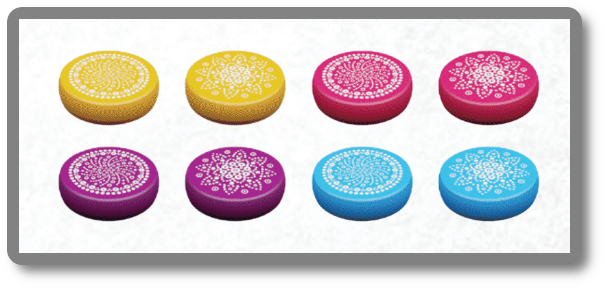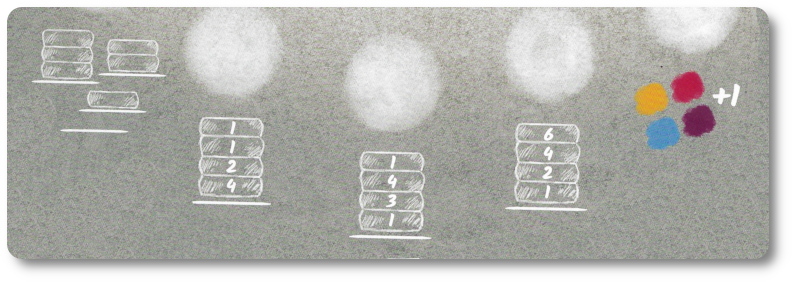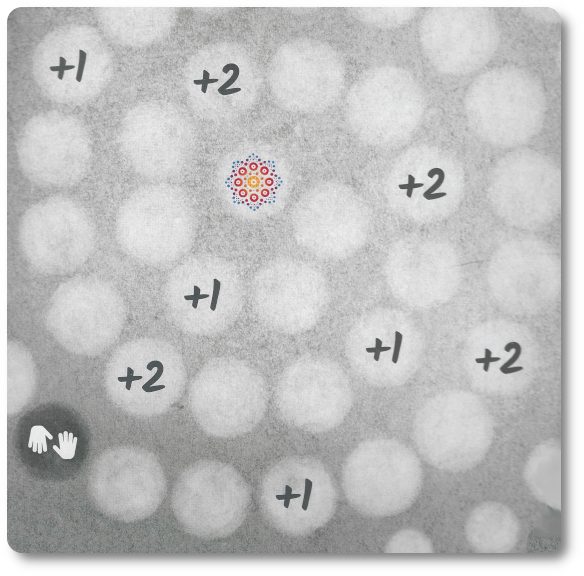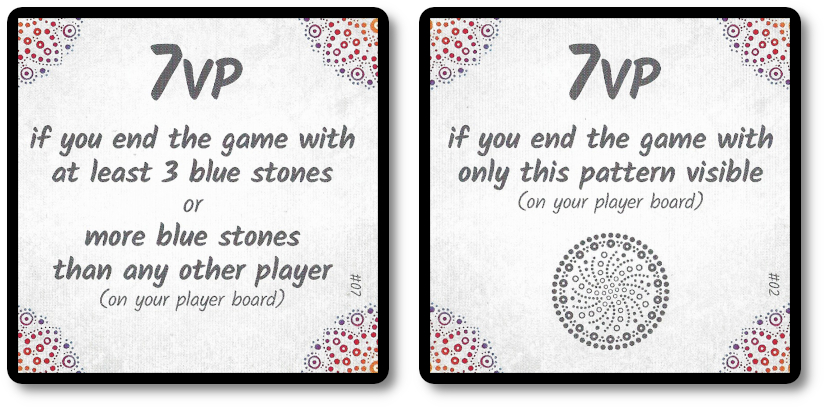
The Basics:
- For ages 10 and up
- For 2 to 4 players
- Approximately 30 minutes to complete
Geek Skills:
- Counting & Math
- Logical & Critical Decision Making
- Reading
- Pattern/Color Matching
- Strategy & Tactics
- Visuospatial Skills
- Hand/Resource Management
Learning Curve:
- Child – Moderate
- Adult – Easy
Theme & Narrative:
- Create a piece of beautiful art that is tricky to score
Endorsements:
- Gamer Geek mixed!
- Parent Geek approved!
- Child Geek rejected!
Overview
Dutch post-impressionist painter, Vincent van Gogh, said, “The great artist is the simplifier.” In this game, players will be asked to make what is seemingly simple decisions, collecting colors, and creating patterns, with the intent of creatively scoring while at the same time creating art. All the while, the player’s opponents are doing the same. Artists might be simplifiers, but when you share a small canvas with more than one, things go from simple to elaborately complex.
Mandala Stones, designed by Filip Głowacz and published by Board & Dice, is comprised of four Player boards, 10 Objective cards, one Main board, four Reference cards, 96 Stones (in four different colors; 24 per color), 1 Mandala board, four Artist markers, four Scoring markers, four “+50” VP markers, and one cotton bag. The game component quality is, for the most part, excellent with thick plastic Stones, solid wood markers, and heavy board. The one disappointing component choice was the Player boards that are much thinner than the other boards. This gives one the impression that the publishing company didn’t put as much effort into the Player boards itself, which is a real shame, considering that this particular board is front and center of the player. To be clear, it isn’t bad. It just feels out of place. Like having a $50 steak served with a wilted side salad topped with stale croutons. It feels like a cheap afterthought when put side by side with the rest.
Preparing for Creation
To set up the game, first place the Main board in the middle of the playing area and within easy reach of all the players.
Second, place all the Stones in the cotton bag and shake. Drawing one Stone at a time, place a stacked column of four Stones per column on the specially marked spaces found on the Main board.
Third, randomly place each of the four Artist markers on the specially marked spaces found on the Main board.
Fourth, place the Mandala board next to the Main board. Now leave it alone.
Fifth, give each player a Player board and one Scoring marker. Players place the Player board in front of them and place the Scoring marker on the specially marked space on the Player board “Victory Point track.”
Sixth, shuffle the Objective cards and deal two to each player. Players should look at the Objective cards they were given, keeping their Objective cards hidden from opponents until revealed at the end of the game. Gamers love a good mystery!
That’s it for game set up. Determine who will go first and begin!
The Metaphysical, Physically Speaking…
Mandala Stones is played in rounds and turns with no set number of rounds per game. A player’s turn is comprised of two possible actions. Only one action can be taken per turn. Each action is summarized here.
Action Option One: Pick a Stone
This action is only possible if the player has empty spaces on their Player board. If they do not, they can only take the Score action. In addition, it’s possible that a player cannot legally move an Artist marker. In which case, the player is also forced to take the Score action.
The player selects one of the four Artist markers on the Main board and moves it to any open space.
After the Artists marker is moved, the player takes all the Stones on the top of the four adjacent stacks to the Artist marker just moved, with a few limitations.
- No Stones can be taken from a stack that is adjacent to another Artist marker on the Main board
- Only Stones matching the symbol on the Artist marker can be taken.

But wait, there’s more!
After selecting which Stones are available, the player needs to carefully consider the order to collect the Stones. We’ll call the first Stone collected the “starting Stone.” After the player completes the move with the starting Stone, they continue clockwise around the moved Artists marker to the next applicable stack where a Stone can be collected. This continues until all the applicable stacks have been resolved.
When the player takes a Stone, they place it down in front of them. The next collected Stones goes on top of that Stone. In this way, the player creates a stack of the collected Stones, with the first collected Stone at the bottom and the last on the top. This new stack is referred to as a “Tower.”
The player now moves this newly created Tower (without rearranging the Stone order) to their Player board, placing it on any of the five possible spaces, but only if that space is empty (does not contain any Stones).
Action Option Two: Score Stones
The player has decided (or is forced to) score the Stones they have collected so far. There are two possible methods to score points. Only one scoring method can be taken per turn for this particular action. Each scoring method is summarized here.
Score by Color
This scoring method allows the player to select one of the four colors they have collected so far and are shared by at least two of the Stones on the top of the Towers on their Player board. Scoring each Tower should be done from the player’s left to the player’s right, per their seated position to their Player board. Each Tower of the selected color is scored individually using five different options. Wow, there are a lot of options in this game…
- Score one victory point for each different height among all the Towers on the Player board
- Score different amount of victory points based on the number of Stones per Towers on the Player board
- Score different amount of victory points based on the number of Stones in a specific Tower on the Player board (two different ways to count the Tower)
- Score different amount of victory points based on the number of different colors in the Tower, plus one additional point
Each is summarized on the Player board to help players remember these different scoring options, as shown in the below image.

The points earned are added together, and the player moves their Score marker accordingly on their Player board. The player then removes the top colored Stones from their Towers used to score, placing them on the Mandala board in any order they like, starting with the first unoccupied space nearest the Mandala board’s center and continuing through the spiral.

There are special spaces on the Mandala board. When a player covers one of these spaces with a Stone, they take the action noted. Actions include the following:
- Score an additional +1 or +2 victory points
- Trigger the endgame
Score by Top Stones
The other scoring method is significantly faster and easier. The player selects any number of the top Stones on their Tower and scores +1 victory point for each selected Stone removed. Individual colors and patterns do not matter when using this scoring method.
The points earned are added together, and the player moves their Score marker accordingly on their Player board. The player then removes the selected Stones from their Towers used to score, placing them on the Mandala board in any order they like, starting with the first unoccupied space nearest the Mandala board’s center.
Like the first scoring method, the player will resolve any special spaces on the Mandala board as required when they place a Stone.
After the player has taken one of the two optional actions (picking Stones or scoring Stones), their turn is over. The next player in turn order sequence now takes their turn.
Endgame and Final Scoring of the Path
The game will come to an end in one of two possible ways.
The first is if a player places a Stone on the Mandala board special space that triggers the end game. If this occurs, the round is completed, ensuring all players have the same number of turns.
The second occurs if any player cannot take a Stone with the Pick a Stone optional action and cannot take the Score Stone action. In that order. If this occurs, the game ends immediately regardless of how many players haven’t had a chance to finish their turn in the round.
Players now determine their final score. During the game, all players were keeping track of the victory points earned. All that remains is revealing the super-secret Objective cards each player was given at the start of the game. In turn order sequence, each player reveals their Objective cards and selects one to use.
Each of the Objective cards has a certain condition that must be met (a condition, by the way, the player should be aware of when making decisions on their turn). If the condition is successfully met, the bonus victory points are added to the player’s Victory Point track.

After all the players have revealed the Objective card and updated their points accordingly, the player with the most points scored wins the game. Ties are broken by turn order, but I prefer a good old-fashioned fistfight.
To learn more about Mandala Stones, visit the game’s webpage.
Final Word
 The Child Geeks really thought they would enjoy this game. Ultimately, what caused them to not warm up to it was the scoring. According to one Child Geek, “I get the game. I really do. What you need to do is easy. What I don’t think is fun and think is really hard are all the different ways you can score. When do I score? I don’t know, and it made me feel stressed.” Another Child Geek said, “I think the game is fun, but I didn’t know how to score points. Even when my parents helped, I still didn’t know what was going on.” The Child Geeks all had similar experiences when playing. They all reported that the game was easy to learn and fun to play, but not once did this young group of up-and-coming geeks grasp the game’s scoring methods. This resulted in Mandala Stones scoring very low with the Child Geeks.
The Child Geeks really thought they would enjoy this game. Ultimately, what caused them to not warm up to it was the scoring. According to one Child Geek, “I get the game. I really do. What you need to do is easy. What I don’t think is fun and think is really hard are all the different ways you can score. When do I score? I don’t know, and it made me feel stressed.” Another Child Geek said, “I think the game is fun, but I didn’t know how to score points. Even when my parents helped, I still didn’t know what was going on.” The Child Geeks all had similar experiences when playing. They all reported that the game was easy to learn and fun to play, but not once did this young group of up-and-coming geeks grasp the game’s scoring methods. This resulted in Mandala Stones scoring very low with the Child Geeks.
 On the other hand, the Parent Geeks found the game to be very entertaining, casual, and with a lot of options to score… or not. According to one Parent Geek, “I think the game is gorgeous, and you create some fascinating patterns. The hardest part of the game is knowing when to score. You can also ways score points; I want to make sure everyone understands that. But I spent a lot of time during the game second-guessing my scoring.” Another Parent Geek said, “Fun game. Really enjoyed it. The gameplay itself was just OK, but what will keep me coming back for more is the way you score points. So many options! I had a lot of fun thinking through my moves while others completed theirs. Great stuff for a casual game!” When all the votes were in, the Parent Geeks unanimously agreed that Mandala Stones was as interesting as it was pretty, resulting in their full endorsement.
On the other hand, the Parent Geeks found the game to be very entertaining, casual, and with a lot of options to score… or not. According to one Parent Geek, “I think the game is gorgeous, and you create some fascinating patterns. The hardest part of the game is knowing when to score. You can also ways score points; I want to make sure everyone understands that. But I spent a lot of time during the game second-guessing my scoring.” Another Parent Geek said, “Fun game. Really enjoyed it. The gameplay itself was just OK, but what will keep me coming back for more is the way you score points. So many options! I had a lot of fun thinking through my moves while others completed theirs. Great stuff for a casual game!” When all the votes were in, the Parent Geeks unanimously agreed that Mandala Stones was as interesting as it was pretty, resulting in their full endorsement.
 The Gamer Geeks found the gameplay to be “OK” to “meh.” According to one Gamer Geek, “A solid abstract casual game, but the only thing it really has going for it is how you score points. I like there are so many options, which makes you feel like you are always on the lookout for the big score. The trick is finding them and with the proper timing. Get your stones in the right space, and you can jump ahead of the competition pretty fast. The game rewards deep thinking, which is funny, considering how casual the rest of the game is.” Another Gamer Geek said, “I cannot decide if I like this game or am neutral towards it. I certainly don’t love it, but it kept me hooked. I would play it again, and I think I’d rather play this with casual players than hardcore gamers. The game feels relaxing with what I think is a bit too overly busy scoring mechanism thrown in.” When the last stone was collected and scored, the Gamer Geeks were fairly mixed, finding Mandala Stones an interesting game but not a great game.
The Gamer Geeks found the gameplay to be “OK” to “meh.” According to one Gamer Geek, “A solid abstract casual game, but the only thing it really has going for it is how you score points. I like there are so many options, which makes you feel like you are always on the lookout for the big score. The trick is finding them and with the proper timing. Get your stones in the right space, and you can jump ahead of the competition pretty fast. The game rewards deep thinking, which is funny, considering how casual the rest of the game is.” Another Gamer Geek said, “I cannot decide if I like this game or am neutral towards it. I certainly don’t love it, but it kept me hooked. I would play it again, and I think I’d rather play this with casual players than hardcore gamers. The game feels relaxing with what I think is a bit too overly busy scoring mechanism thrown in.” When the last stone was collected and scored, the Gamer Geeks were fairly mixed, finding Mandala Stones an interesting game but not a great game.
 Mandala Stones will make you think. It approaches the player very casually and comes across as little more than a set collecting and pattern matching game. Which it is, but it’s also a lot more. Timing of when you score is just as important as how you score. And this was, to me, the most interesting aspect of the game itself. Moving the Artists around felt like a bit of a stretch regarding “fun,” but it did provide an additional level of complexity that – again – all goes back to timing.
Mandala Stones will make you think. It approaches the player very casually and comes across as little more than a set collecting and pattern matching game. Which it is, but it’s also a lot more. Timing of when you score is just as important as how you score. And this was, to me, the most interesting aspect of the game itself. Moving the Artists around felt like a bit of a stretch regarding “fun,” but it did provide an additional level of complexity that – again – all goes back to timing.
The Objective cards are nice, but what I believe defines the game’s replayability is how the game is always randomly set. You cannot create a strategy for this game. The Stones are all over the place, as are the colors and the players scoring their Stones. The game always felt fresh, with a new twist to how I needed to make my moves. This, honestly, will lead many to believe that the game is mostly about reacting. It’s not. Your moves each turn are focused on acting on what you can do at the moment. This is also why you can’t do much in the way of a strategy. For those gamers who like a game you can get better at, the only real skill in Mandala Stones is learning how to see patterns within patterns.
Which sounds very zen… or Matrix-like, I suppose. The truth is, after playing the game many times, I don’t feel like I am any better at it. I do, however, know what to look for in the Stone Towers, and this had me appreciate the timing of the scoring, seeing the different ways to score in the rounds to come.
And there is that word again. “Timing.” Maybe they should have named this game “Time Stones,” which has a nice ring to it…
Overall, I enjoyed the game and looked forward to playing it again. The perfect audience for this pretty game is most certainly the casual crowd. Pull up a chair, pour yourself a drink, and dive into the colorful display you will create as you build upon the growing spiral one stone at a time with everyone helping out. It’s peaceful, like a coloring book, but still engrossing enough as a game to keep you looking for opportunities. Do give this game a try when you get a chance to see if these stones tickle your fancy.
This game was given to Father Geek as a review copy. Father Geek was not paid, bribed, wined, dined, or threatened in vain hopes of influencing this review. Such is the statuesque and legendary integrity of Father Geek.



